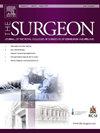The effect of timing of emergency cholecystectomy for acute cholecystitis on peri-operative outcomes: A national registry-based study
IF 2.3
4区 医学
Q2 SURGERY
Surgeon-Journal of the Royal Colleges of Surgeons of Edinburgh and Ireland
Pub Date : 2025-07-08
DOI:10.1016/j.surge.2025.06.004
引用次数: 0
Abstract
Introduction
A selection of international guidelines suggest that emergency cholecystectomy within 72 h of admission is the treatment of choice for acute cholecystitis. The aim of this study was to analyse the interval from presentation to operative intervention for acute cholecystitis in Ireland and its impact on peri-operative outcomes.
Methods
This was a national retrospective observational study of all patients that underwent an emergency cholecystectomy for acute cholecystitis in Ireland between January 2017 and July 2023. Data collected included: demographics, co-morbidities, length of stay, operative approach, post-operative interventions, in-patient mortality, and readmissions. Subjects were stratified based on time from presentation to theatre and outcomes were compared between groups.
Results
3585 patients underwent an emergency cholecystectomy for acute cholecystitis–2005(55.9 %) within 72 h of admission, 1072(29.9 %) within 72 hours-7 days, 416(11.6 %) within 8–14 days and 92(2.6 %) beyond 14 days. Earlier progression to theatre was predicted by female sex (X2(3) = 10.402,p = 0.015), less co-morbidities (X2(12) = 95.723,p=<0.001), and younger age (H(3) = 92.591,p=<0.001).
On logistic regression, age >65(OR 1.565,p < 0.001), male sex(OR 1.348,p = 0.002), increasing co-morbidities(OR 1.586,p = 0.009) and increased “time to theatre”(72hrs-7days(OR 1.616,p < 0.001), 8–14days(OR 3.84,p < 0.001), >14days(OR 5.929,p < 0.001)) were risk factors for a composite of adverse outcomes (mortality, 30-day readmission, post-operative ERCP/IR drain, conversion to open, CBD injury). Subgroup analysis of the <72 h group displayed no difference in outcome.
Conclusion
Despite international guidance, just over half of emergency cholecystectomies for acute cholecystitis are performed within 72 h in Ireland. Prolonging “time to theatre” is associated with a stepwise deterioration in outcomes across a wide variety of measures.
急性胆囊炎急诊胆囊切除术时机对围手术期预后的影响:一项基于全国登记的研究。
引言:一些国际指南建议在入院后72小时内进行急诊胆囊切除术是急性胆囊炎的首选治疗方法。本研究的目的是分析爱尔兰急性胆囊炎从出现到手术干预的时间间隔及其对围手术期结果的影响。方法:这是一项全国性的回顾性观察研究,纳入了2017年1月至2023年7月在爱尔兰因急性胆囊炎接受紧急胆囊切除术的所有患者。收集的数据包括:人口统计学、合并症、住院时间、手术方式、术后干预、住院死亡率和再入院率。根据从演讲到剧院的时间对受试者进行分层,并比较各组之间的结果。结果:3585例急性胆囊炎患者行急诊胆囊切除术,其中入院72小时内2005例(55.9%),72小时-7天内1072例(29.9%),8-14天内416例(11.6%),14天以上92例(2.6%)。女性更早进入手术室(X2(3) = 10.402,p = 0.015),更少的合病(X2(12) = 95.723,p=65(OR 1.565, OR 5.929,p)结论:尽管有国际指导,在爱尔兰,超过一半的急性胆囊炎急诊胆囊切除术在72小时内完成。延长“进入手术室的时间”与各种措施的结果逐步恶化有关。
本文章由计算机程序翻译,如有差异,请以英文原文为准。
求助全文
约1分钟内获得全文
求助全文
来源期刊
CiteScore
4.40
自引率
0.00%
发文量
158
审稿时长
6-12 weeks
期刊介绍:
Since its establishment in 2003, The Surgeon has established itself as one of the leading multidisciplinary surgical titles, both in print and online. The Surgeon is published for the worldwide surgical and dental communities. The goal of the Journal is to achieve wider national and international recognition, through a commitment to excellence in original research. In addition, both Colleges see the Journal as an important educational service, and consequently there is a particular focus on post-graduate development. Much of our educational role will continue to be achieved through publishing expanded review articles by leaders in their field.
Articles in related areas to surgery and dentistry, such as healthcare management and education, are also welcomed. We aim to educate, entertain, give insight into new surgical techniques and technology, and provide a forum for debate and discussion.

 求助内容:
求助内容: 应助结果提醒方式:
应助结果提醒方式:


